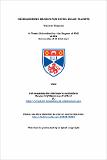Files in this item
Microlensing search for extra solar planets
Item metadata
| dc.contributor.author | Tsapras, Yiannis | |
| dc.coverage.spatial | 147 | en_US |
| dc.date.accessioned | 2015-07-31T14:10:34Z | |
| dc.date.available | 2015-07-31T14:10:34Z | |
| dc.date.issued | 2002 | |
| dc.identifier | uk.bl.ethos.489562 | |
| dc.identifier.uri | https://hdl.handle.net/10023/7092 | |
| dc.description.abstract | Gravitational microlensing may be used to probe distant stars for planetary companions. The presence of a planet in the vicinity of a star acting as the lens may cause a short lived anomaly in the observed lightcurve of the lensing event. By quantifying these anomalies we may place limits on the mass of the companion relative to the lens as well as the position of the planet relative to the primary lens. The detection probability is proportional to mp, where mp is the planet mass. All current follow-up teams use dedicated observations on a preselected sample of mainly high-amplification events. Microlensing has yet to yield an undisputed planetary detection. In chapter 1 we give an introduction to the field of extra-solar planets and proceed to present the theory employed in microlensing studies in chapter 2. Chapter 3 deals with the principles of data aquisition and data reduction techniques that provide the high precision photometry needed for these studies. In the data analysis presented in chapters 4 and 5 of this thesis, we use a different observing approach. We spread our observing time between many targets obtaining 1 to 2 frames per night on each event. Our aim is not to characterize, but only detect the first exoplanetary signal in a microlensing campaign. The pilot run presented in chapter 4 showed it is possible to place significant limits on the presence of planets even from observations performed from a Northern site. In Chapter 5 we analyse data obtained from the JKT at La Palma together with publicly available OGLE data to place useful constraints on the presence of planets orbiting the lens stars. We detect no undisputed planetary signals but calculate high detection probabilities for two events. In chapter 6 we present our analysis of three years (1998-2000) of OGLE data (146 events). We compute the detection probability for each event individually and the total detection probability for the whole sample. Our selection criteria return 6 candidate events, 5 of which could possibly be attributed to planets. However, the OGLE data is insufficient to draw definite conclusions. If we assume that the observed deviations are not due to planetary companions, we conclude that less than 18% of the lens stars have planets with mp = m5., orbiting them at an orbital radius of 1.1 <a<3 AU. We conclude with a summary of this thesis in chapter 7. | en_US |
| dc.language.iso | en | en_US |
| dc.publisher | University of St Andrews | |
| dc.subject.lcc | QB812.T8 | |
| dc.title | Microlensing search for extra solar planets | en_US |
| dc.type | Thesis | en_US |
| dc.type.qualificationlevel | Doctoral | en_US |
| dc.type.qualificationname | PhD Doctor of Philosophy | en_US |
| dc.publisher.institution | The University of St Andrews | en_US |
This item appears in the following Collection(s)
Items in the St Andrews Research Repository are protected by copyright, with all rights reserved, unless otherwise indicated.

